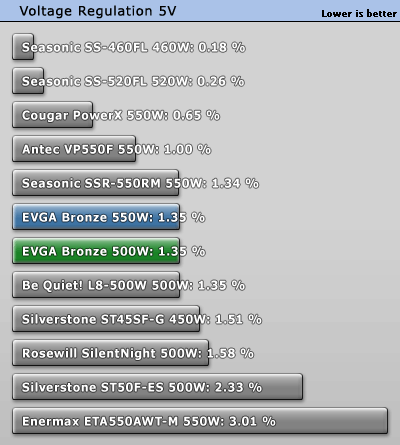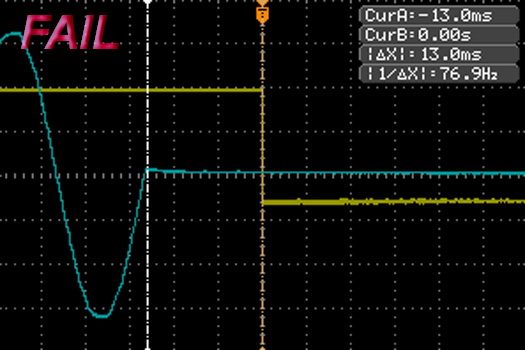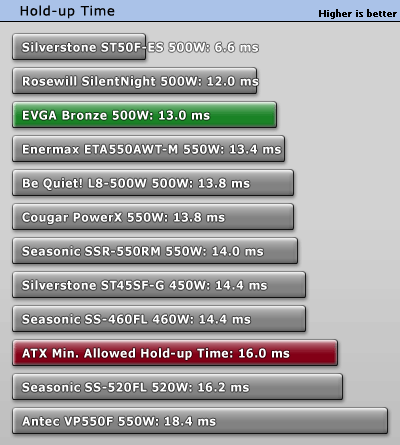 2
2
EVGA Bronze 500 W Review
Efficiency, Temperatures & Noise »Test Setup
All measurements were performed using two Chroma 6314A mainframes equipped with the following electronic loads: six 63123A [350 W each], one 63102A [100 W x2], and one 63101A [200 W]. The aforementioned equipment is able to deliver 2500 W of load, and all loads are controlled by a custom-made software. We also used a Picoscope 3424 oscilloscope, a Picotech TC-08 thermocouple data logger, a Fluke 175 multimeter, and a Yokogawa WT210 power meter. We also included a wooden box, which, along with some heating elements, was used as a hot box. Finally, we had at our disposal four more oscilloscopes (Rigol 1052E and VS5042, Stingray DS1M12, and a second Picoscope 3424), and a CEM DT-8852 sound level meter. In this article, you will find more details about our equipment and the review methodology we follow. Finally, we conduct all of our tests at 40°C-45°C ambient in order to simulate with higher accuracy the environment seen inside a typical system, with 40°C-45°C being derived from a standard ambient assumption of 23°C and 17°C-22°C being added for the typical temperature rise within a system.Primary Rails Voltage Regulation
The following charts show the voltage values of the main rails, recorded over a range from 60 W to the maximum specified load, and the deviation (in percent) for the same load range.





5VSB Regulation
The following chart shows how the 5VSB rail deals with the load we throw at it.

Hold-up Time
The hold-up time is a very important characteristic of a PSU and represents the amount of time, usually measured in milliseconds, that a PSU can maintain output regulations as defined by the ATX spec without input power. In other words, it is the amount of time the system can continue to run without shutting down or rebooting during a power interruption. The ATX spec sets the minimum hold-up time to 16 ms with the maximum continuous output load. In the following screenshot, the blue line is the mains signal and the yellow line is the "Power Good" signal. The latter is de-asserted to a low state when any of the +12V, 5V, or 3.3V output voltages fall below the undervoltage threshold, or after the mains power has been removed for a sufficiently long time to guarantee that the PSU cannot operate anymore.

The small hold-up cap didn't allow the PSU to achieve the minimum allowed hold-up time. These caps don't come cheap so companies prefer to use small ones, especially in budget units.
Inrush Current
Inrush current or switch-on surge refers to the maximum, instantaneous input-current drawn by an electrical device when first turned on. Because of the charging current of the APFC capacitor(s), PSUs produce large inrush-current right as they are turned on. Large inrush current can cause the tripping of circuit breakers and fuses and may also damage switches, relays and bridge rectifiers; as a result, the lower the inrush current of a PSU right as they are turned on, the better.
This unit's inrush current was very low because of the small hold-up cap responsible for its failure in the previous test. This is a good example of even a bad thing bringing about something good.
Voltage Regulation and Efficiency Measurements
The first set of tests revealed the stability of the voltage rails and the efficiency of the 500B. The applied load was equal to (approximately) 20%, 40%, 50%, 60%, 80%, 100%, and 110% of the maximum load that the PSU can handle. We conducted two additional tests. In the first test, we stressed the two minor rails (5V and 3.3V) with a high load while the load at +12V was only 0.10 A. This test reveals whether the PSU is Haswell ready or not. In the second test, we dialed the maximum load the +12V rail could handle while the load on the minor rails was minimal.| Voltage Regulation & Efficiency Testing Data EVGA 500B | ||||||||||
|---|---|---|---|---|---|---|---|---|---|---|
| Test | 12 V | 5 V | 3.3 V | 5VSB | Power (DC/AC) | Efficiency | Fan Speed | Fan Noise | Temp (In/Out) | PF/AC Volts |
| 20% Load | 6.463A | 1.983A | 1.991A | 1.004A | 99.77W | 83.82% | 1176 RPM | 40.8 dBA | 39.76°C | 0.924 |
| 12.098V | 5.042V | 3.308V | 4.975V | 119.03W | 42.58°C | 230.2V | ||||
| 40% Load | 13.317A | 3.981A | 4.016A | 1.210A | 199.67W | 86.49% | 1448 RPM | 43.7 dBA | 40.56°C | 0.963 |
| 12.054V | 5.017V | 3.284V | 4.948V | 230.87W | 43.89°C | 230.1V | ||||
| 50% Load | 16.645A | 4.984A | 5.043A | 1.620A | 249.67W | 86.44% | 1613 RPM | 46.4 dBA | 41.65°C | 0.971 |
| 12.030V | 5.007V | 3.270V | 4.928V | 288.83W | 45.22°C | 230.2V | ||||
| 60% Load | 19.987A | 6.000A | 6.080A | 2.035A | 299.70W | 86.19% | 1773 RPM | 49.1 dBA | 42.92°C | 0.976 |
| 12.005V | 4.996V | 3.256V | 4.906V | 347.74W | 46.99°C | 230.2V | ||||
| 80% Load | 26.883A | 8.036A | 8.176A | 2.459A | 399.64W | 85.50% | 1836 RPM | 50.2 dBA | 44.47°C | 0.983 |
| 11.952V | 4.974V | 3.227V | 4.872V | 467.42W | 49.22°C | 230.2V | ||||
| 100% Load | 34.502A | 9.043A | 9.273A | 3.102A | 499.54W | 84.54% | 1836 RPM | 50.2 dBA | 46.19°C | 0.987 |
| 11.879V | 4.976V | 3.203V | 4.833V | 590.90W | 51.87°C | 230.1V | ||||
| 110% Load | 38.838A | 9.034A | 9.292A | 3.106A | 549.50W | 84.08% | 1836 RPM | 50.2 dBA | 46.40°C | 0.988 |
| 11.839V | 4.982V | 3.196V | 4.826V | 653.55W | 52.35°C | 230.1V | ||||
| Crossload 1 | 0.095A | 14.013A | 14.004A | 0.000A | 111.33W | 76.59% | 1858 RPM | 50.4 dBA | 43.27°C | 0.937 |
| 12.482V | 4.622V | 3.240V | 4.946V | 145.35W | 47.06°C | 230.3V | ||||
| Crossload 2 | 39.969A | 1.001A | 1.002A | 1.002A | 481.60W | 84.98% | 1824 RPM | 50.1 dBA | 46.55°C | 0.986 |
| 11.715V | 5.172V | 3.253V | 4.914V | 566.72W | 52.67°C | 230.1V | ||||
Feb 23rd, 2025 23:26 EST
change timezone
Latest GPU Drivers
New Forum Posts
- How's your old spinner holding up? (37)
- is a 650w gold power supply enough for a amd 7 7700x OR 7 5700x and a msi geforce rtx 4070 super 12go gaming x slim ? (3)
- New fans (3)
- CUDIMM OC Progress (2)
- It's happening again, melting 12v high pwr connectors (896)
- Nvidia's GPU market share hits 90% in Q4 2024 (gets closer to full monopoly) (530)
- Monitor Battle! Help me choose between two contenders (41)
- Dell Workstation Owners Club (3282)
- SLI is really not Dead if you Have a SLI rig (83)
- EFI partition too small, can't update Windows 11 on laptop (12)
Popular Reviews
- ASUS GeForce RTX 5070 Ti TUF OC Review
- MSI GeForce RTX 5070 Ti Ventus 3X OC Review
- darkFlash DY470 Review
- MSI GeForce RTX 5070 Ti Vanguard SOC Review
- MSI GeForce RTX 5070 Ti Gaming Trio OC+ Review
- Galax GeForce RTX 5070 Ti 1-Click OC White Review
- Palit GeForce RTX 5070 Ti GameRock OC Review
- Fantech Aria II Pro Review
- Gigabyte GeForce RTX 5090 Gaming OC Review
- AMD Ryzen 7 9800X3D Review - The Best Gaming Processor
Controversial News Posts
- NVIDIA GeForce RTX 5090 Spotted with Missing ROPs, NVIDIA Confirms the Issue, Multiple Vendors Affected, RTX 5070 Ti, Too (449)
- AMD Radeon 9070 XT Rumored to Outpace RTX 5070 Ti by Almost 15% (304)
- AMD Plans Aggressive Price Competition with Radeon RX 9000 Series (271)
- AMD Radeon RX 9070 and 9070 XT Listed On Amazon - One Buyer Snags a Unit (247)
- Edward Snowden Lashes Out at NVIDIA Over GeForce RTX 50 Pricing And Value (241)
- AMD Denies Radeon RX 9070 XT $899 USD Starting Price Point Rumors (239)
- NVIDIA Investigates GeForce RTX 50 Series "Blackwell" Black Screen and BSOD Issues (227)
- New Leak Reveals NVIDIA RTX 5080 Is Slower Than RTX 4090 (215)